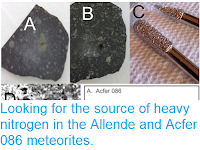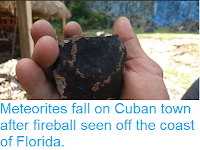A probable meteorite has been handed to the Bihar Museum in Patna after falling in a paddy field in the village of Mahadeva in Madhubani District, Bihar, on Wednesday 24 July 2019. The object is described as weighing about 15 kg, light in colour, and magnetic, which suggests that it may be an iron or nickel-iron meteorites, or octahedrites, which are the most common class of meteorite, and left a hole over a metre deep where it landed. The object is currently on display in the Bihar Museum, though it is planned to send it on the the Srikrishna Science Center to be studied properly.
Villagers in Madhubani District, Bihar, with a possible meteorite that fell nearby on Wednesday 24 July 2019. NDTV.
A meteorite falling from the sky without previously being seen seems unlikely, but a small object entering the Earth's atmosphere in daytime over India would not necessarily produce a bright enough meteor to be seen (a 'meteor' is a bright light in the sky caused by an extra-terrestrial object entering the atmosphere, a meteorite is a piece of rock that is derived from such an object). The brightness of a meteor is caused by friction with
the Earth's atmosphere, which is usually far greater than that caused
by simple falling, due to the initial trajectory of the object. Such
objects typically eventually explode in an airburst called by the
friction, causing them to vanish as an luminous object. However this is
not the end of the story as such explosions result in the production of a
number of smaller objects, which fall to the ground under the influence
of gravity (which does not cause the luminescence associated with
friction-induced heating).
Impact crater left by the 24 July 2019 Bihar meteorite. CNN.
These 'dark objects' do not continue along the path
of the original bolide, but neither do they fall directly to the ground,
but rather follow a course determined by the atmospheric currents
(winds) through which the objects pass. Scientists that have witnessed meteors are sometimes able to calculate potential trajectories for hypothetical dark
objects derived from meteors using data from weather monitoring services.
See also...
Follow Sciency Thoughts on Facebook.








